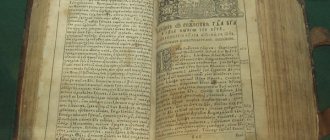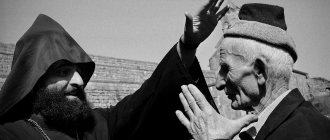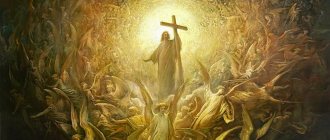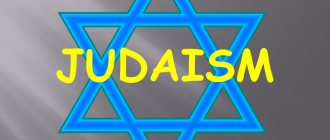Report Christianity message
Christianity, according to historical data, arose a very long time ago, around the first century BC. Presumably it was founded in Rome. This faith carried an appeal to all the needy and abused who wanted to find justice. It was based on the hope for a better deliverance from everything bad that happened on Earth.
They worshiped the Divine Being - God. For all human sins, the son of God Jesus Christ was punished, which translated means the Savior of sinful souls. Associated with this name is the Christian prophecy that the son of God will come to earth in human flesh and free all people from evil and suffering. And righteous life will come to the earth and the kingdom of God will come. Christians believed that with the coming of God to the sinful Earth there would be a terrible judgment for all living and dead people, and only he would decide and judge people. Many of whom will go to hell for their deeds, and people who bring light and kindness will be rewarded and sent to heaven.
The main characteristics of the Christian idea are as follows:
- Faith. God is one. He created the entire Universe
- Faith in the sacrifice of atonement performed by the Son of God Jesus Christ. He was both God and man.
- Belief in the mysterious power of God
- Belief in life after death
- Belief in angels and evil spirits - demons.
- Belief in Satan, the patron of evil spirits.
The main and sacred book of all Christian believers is the Bible; it consists of two parts:
- First part of the Old Testament
- New Testament (4 Gospels, which describes the deeds of the son of God)
The Bible describes the faith of mankind, how God searched for man. The main feature of Christian beliefs is churches.
There are several main branches of Christianity:
- Catholicism
- Orthodoxy, it includes 15 Orthodox churches and several autonomous ones
Protestantism is divided into several movements:
- Lutheranism
- Calvinism
- Anglicanism
- Sectarianism includes Baptists, Methodists, Adventists and many others
3rd, 4th grade
LiveInternetLiveInternet
Most of the world's population believes in God, the Father and the Holy Spirit, prays in churches, reads the Holy Scriptures, listens to cardinals and patriarchs. These are Christians . So what is Christianity? Christianity (from the Greek Χριστός - “anointed one”, “messiah”) is an Abrahamic world religion based on the life and teachings of Jesus Christ, described in the New Testament. Christians believe that Jesus of Nazareth is the Messiah, the Son of God and the Savior of mankind. Christians do not doubt the historicity of Jesus Christ.
What is Christianity
In short, it is a religion based on the belief that more than 2000 years ago God came to our world. He was born, received the name Jesus, lived in Judea, preached, suffered and died on the cross as a man. His death and subsequent resurrection from the dead changed the fate of all mankind. His preaching marked the beginning of a new European civilization. What year are we all living in? The students answer. This year, just like others, we count from the birth of Christ.
Christianity is the largest world religion, both in terms of the number of adherents, of which there are about 2.1 billion, and in terms of geographical distribution - almost every country in the world has at least one Christian community.
More than 2 billion Christians belong to various religious denominations. The largest movements in Christianity are Orthodoxy, Catholicism and Protestantism. In 1054, the Christian Church split into Western (Catholic) and Eastern (Orthodox). The emergence of Protestantism was the result of the reformation movement in the Catholic Church in the 16th century.
Interesting facts about religion
Christianity originates from the beliefs of a group of Palestinian Jews who believed that Jesus was the messiah, or “anointed one” (from the Greek Χριστός - “anointed one”, “messiah”), who would free the Jews from Roman rule. The new teaching was spread by the Master's followers, especially by the Pharisee Paul, who converted to Christianity. Traveling through Asia Minor, Greece, and Rome, Paul preached that faith in Jesus freed his followers from observing the rituals required by the Law of Moses. This attracted numerous non-Jews to the Christian faith, searching for an alternative to Roman paganism, but at the same time unwilling to recognize the obligatory rites of Judaism. Despite the fact that the Roman authorities from time to time renewed the fight against Christianity, its popularity grew rapidly. This continued until the era of Emperor Decius, under whom (250) the systematic persecution of Christians began. However, instead of weakening the new faith, oppression only strengthened it, and in the 3rd century. Christianity spread throughout the Roman Empire.
Before Rome, in 301, Christianity was adopted as the state religion by Armenia, then an independent kingdom. And soon the victorious march of the Christian faith across Roman lands began. From the very beginning, the Eastern Empire was built as a Christian state. Emperor Constantine, the founder of Constantinople, stopped the persecution of Christians and patronized them. Under Emperor Constantine I, starting with the edict of 313 on freedom of religion, Christianity began to acquire the status of a state religion in the Roman Empire, and on his deathbed in 337 he was baptized. He and his mother, Christian Elena, are revered by the Church as saints. Under Emperor Theodosius the Great at the end of the 4th century. Christianity in Byzantium established itself as the state religion. But only in the 6th century. Justinian I, a zealous Christian, finally banned pagan rituals on the lands of the Byzantine Empire.
In 380, under Emperor Theodosius, Christianity was proclaimed the official religion of the empire. By that time, the Christian faith had come to Egypt, Persia and, possibly, to the southern regions of India.
Around 200, church leaders began selecting the most authoritative Christian writings, which later compiled the books of the New Testament that were included in the Bible. This work continued until 382. The Christian Creed was adopted at the Council of Nicaea in 325, but as the church's influence expanded, disagreements regarding doctrine and organizational issues increased.
Beginning with cultural and linguistic differences, the confrontation between the Eastern Church (with its center in Constantinople) and the Western Roman Church gradually acquired a dogmatic character and led to a schism in the Christian Church in 1054. After the capture of Constantinople by the Crusaders in 1204, the division of churches was finally established.
Political, social and scientific revolutions of the 19th century. brought new challenges to Christian doctrine and weakened ties between church and state. Advances in scientific thought posed a challenge to biblical beliefs, especially the creation story, which had been challenged by Charles DARWIN's theory of evolution. However, it was a time of intense missionary activity, especially on the part of the Protestant churches. The stimulus for it was the emerging social consciousness. Christian faith often became an important factor in the organization of many social movements: for the abolition of slavery, for the passage of legislation to protect workers, for the introduction of education and social security.
In the 20th century, in most countries the church was almost completely separated from the state, and in some it was forcibly banned. In Western Europe, the number of believers is steadily declining, while in many developing countries, on the contrary, it continues to grow. Recognition of the need for church unity found expression in the creation of the World Council of Churches (1948).
The spread of Christianity in Russia
The spread of Christianity in Russia began around the 8th century, when the first communities were founded in Slavic territories. They were approved by Western preachers, and the influence of the latter was small. For the first time, the pagan prince Vladimir decided to truly convert Rus', who was looking for a reliable ideological bond for disunited tribes, whose native paganism did not satisfy his needs.
However, it is possible that he himself sincerely converted to the new faith. But there were no missionaries. He had to besiege Constantinople and ask the hand of a Greek princess to be baptized. Only after this were preachers sent to Russian cities, who baptized the population, built churches and translated books. For some time after this, there was pagan resistance, uprisings of the Magi, and so on. But after a couple of hundred years, Christianity, the spread of which had already covered all of Rus', won, and pagan traditions sank into oblivion.
Christian symbols
For Christians, the whole world, which is the creation of God, is full of beauty and meaning, filled with symbols. It is no coincidence that the holy fathers of the Church argued that the Lord created two books - the Bible, which glorifies the love of the Savior, and the world, which glorifies the wisdom of the Creator. All Christian art in general is deeply symbolic.
The symbol connects the two halves of the split world - the visible and the invisible, and reveals the meaning of complex concepts and phenomena. The most important symbol of Christianity is the cross.
The cross can be drawn in different ways - it depends on the directions of Christianity. Sometimes one glance at the image of a cross depicted on a church or cathedral is enough to tell which Christian movement the building belongs to. Crosses can be eight-pointed, four-pointed, or with two bars, and in general there are dozens of variants of crosses. A lot can be written about the existing variants of the image of the cross, but the image itself is not so important; the meaning of the cross itself plays a more important role.
The cross is more of a symbol of the sacrifice that Jesus made to atone for human sins. In connection with this event, the cross became a sacred symbol and very dear to every Christian believer.
The symbolic image of a fish is a symbol of the Christian religion. Pisces, namely its Greek description, can be seen in the abbreviation Son of God the Savior Jesus Christ. The symbolism of Christianity includes a large number of Old Testament symbols: the dove and the olive branch from the chapters that were dedicated to the Flood. Entire legends and parables were formed not only about the Holy Grail, entire troops were sent in search of it. The Holy Grail was the cup from which Jesus and his disciples drank at the Last Supper. The cup had miraculous properties, but traces of it were long lost. New Testament symbols include grape ash, which symbolizes Christ - the grape bunches and vines symbolize the bread and wine of the sacrament, the blood and body of Jesus.
Ancient Christians recognized each other by certain symbols, while other groups of Christians wore symbols with honor on their chests, and some were the cause of wars, and some symbols will be of interest even to those who are far from the Christian religion. The symbols of Christianity and their meanings can be described endlessly. Nowadays, information about symbols is open, so everyone can independently find information about the symbols of Christianity, read their history and become familiar with the reasons for their occurrence, but we decided to tell you about some of them.
The stork symbolizes prudence, vigilance, piety and chastity. The stork heralds the coming of spring, which is why it is called the Annunciation to Mary with the good news of the coming of Christ. There is a Northern European belief that a stork brings children to mothers. They began to say this because of the connection between the bird and the Annunciation.
The stork in Christianity symbolizes piety, purity and resurrection. But the Bible lists stilted birds as unclean, but the stork is seen as a symbol of happiness, largely due to the fact that it eats snakes. By this he points to Christ and his disciples who were engaged in the destruction of satanic creatures.
An angel with a fiery sword is a symbol of Divine justice and wrath.
An angel with a trumpet symbolizes the Last Judgment and resurrection.
A wand topped with a lily or the white lily itself are considered symbols of innocence and purity. The constant and traditional attribute of Gabriel, who with a white lily, appeared in the Annunciation to the Virgin Mary. The lily flower itself symbolizes the virgin purity of the Virgin Mary.
The butterfly is a symbol of new life. This is one of the most beautiful symbols of resurrection, as well as eternal life. A butterfly has a short life, which can be divided into three stages.
- The stage without beauty is the larva (caterpillar).
- The stage of transformation into a cocoon (pupa). The larva begins to envelop itself, sealing itself in an envelope.
- The stage of breaking the silk shell and coming out. Here a mature butterfly appears with a renewed and beautiful body with wings painted in bright colors. Very quickly the wings get stronger and she takes off into the air.
Surprisingly, these three life stages of the butterfly are similar to life in humiliation, burial and death, and then the resurrection of Christ.
He was born in a human body as a servant. The Lord was buried in the grave and on the third day, already in the Orthodox body, Jesus was resurrected and after forty days he ascended into heaven. People who believe in Christ also experience these three stages. By nature, mortal and sinful beings live in humiliation. Then death comes, and lifeless bodies are buried. When Christ returns in glory, on the Last Day Christians will follow Him in renewed bodies that are created in the image of the Body of Christ.
The squirrel is a Christian symbol of greed and avarice. The squirrel is associated with the devil, embodied in an elusive, swift and reddish animal.
A crown made from thorny thorns . Christ suffered not only moral suffering, there was also physical torment that he experienced at trial. He was bullied several times: one of the servants hit him at Anna’s during his first interrogation; he was also beaten and spat on; whipped; he was crowned with a crown made of thorns. The governor's soldiers took Jesus to the praetorium, called the whole regiment, stripped Him and put a scarlet robe on Him; when they wove a crown from thorns, they put it on His head and gave him a reed in his hands; they knelt before Him and mocked Him, beat Him on the head with a cane and spat on Him.
The raven in Christianity is a symbol of hermit life and solitude.
The bunch of grapes is a symbol of the fertility of the promised land. Grapes were grown everywhere in the Holy Land, most often in the hills of Judea.
The Virgin Mary also has a symbolic meaning. The Virgin Mary is the personification of the church.
The woodpecker is a symbol in Christianity of the devil and heresy, which destroy human nature and lead him to damnation.
The crane symbolizes fidelity, good life and asceticism.
The font is a symbol of the virgin's immaculate womb. It is from this that the initiate is born again.
The apple is a symbol of evil.
Traditionally, Christian churches have a cross in their plan - a symbol of the cross of Christ as the basis of eternal salvation, a circle (rotunda type of temple) - a symbol of eternity, a square (quadrangle) - a symbol of the earth, where peoples converge in the temple from four directions of the world, or an octagon (octagon on a quadrangle) ) - symbol of the guiding star of Bethlehem. Each temple is dedicated to some Christian holiday or saint, whose memorial day is called a temple (throne) holiday. Sometimes several altars (chapels) are arranged in the temple. Then each of them is dedicated to its own saint or event.
According to tradition, the temple is usually built with the altar facing east. However, there are exceptions when the liturgical east may not correspond to the geographical one (for example, the Church of the Martyr Julian of Tarsus in Pushkin (the altar is facing south), the Church of the Assumption of the Blessed Virgin Mary in the Tver region (the village of Nikolo-Rozhok) (the altar is facing north)). Orthodox churches were not built with the altar facing west. In other cases, orientation to the cardinal points could be explained by territorial conditions. The roof of the temple is crowned with a dome with a cross. According to widespread tradition, Orthodox churches can have: * 1 chapter - symbolizes the Lord Jesus Christ; * 2 chapters - the two natures of Christ (divine and human); * 3 chapters - Holy Trinity;
* 4 chapters of the Four Gospels, four cardinal directions. * 5 chapters - Christ and the four evangelists; * 7 chapters - seven Ecumenical Councils, seven Christian sacraments, seven virtues;
* 9 chapters - nine ranks of angels; * 13 chapters - Christ and 12 apostles.
The shape and color of the dome also have a symbolic meaning. The helmet shape symbolizes the spiritual warfare (struggle) that the Church wages against the forces of evil.
The shape of the onion symbolizes the candle flame.
The unusual shape and bright colors of the domes, such as that of the Church of the Savior on Spilled Blood in St. Petersburg, speaks of the beauty of heavenly Jerusalem - Paradise.
The domes of churches dedicated to Christ and the Twelve Feasts are gilded/
The blue domes with stars indicate that the temple is dedicated to the Blessed Virgin Mary.
Temples with green or silver domes are dedicated to the Holy Trinity.
In the Byzantine tradition, the dome was covered directly over the vault; in the Russian tradition, due to the “stretching” of the dome’s shape, a space arose between the vault and the dome. In an Orthodox church there are three parts: the vestibule , the main volume of the temple - the catholicon (middle part) and the altar . In the narthex there used to be those who were preparing for baptism and penitents who were temporarily excommunicated from communion. The porches in monastery churches were often also used as refectory areas.
The main parts of an Orthodox church (schematic representation).
The altar is the place of the mysterious presence of the Lord God, and is the main part of the temple. The most important place in the altar is the throne in the shape of a quadrangular table, it has two clothes: the lower one is made of white linen (srachitsa) and the upper one is made of brocade (inditiya). The symbolic meaning of the throne is as a place where the Lord invisibly dwells. On the throne there is an antimension - the main sacred object of the temple. This is a silk cloth consecrated by the bishop with the image of the position of Christ in the tomb and with a sewn-in particle of the relics of a saint. This is due to the fact that in the first centuries of Christianity, the service (liturgy) was performed at the tombs of the martyrs over their relics. Antimins is stored in a case (iliton).
Near the eastern wall in the altar there is a “ high place ” - an elevated seat intended for the bishop and a sintron - an arched bench for the clergy, adjacent from the inside to the eastern wall of the altar, symmetrically to its longitudinal axis. By the XIV-XV centuries. the stationary syntron disappears completely. Instead, during bishop's services, a portable chair without backs and arms is installed.
The altar part is separated from the katholikon by an altar barrier - an iconostasis . In Rus', multi-tiered iconostases appeared in the beginning. XV century (Assumption Cathedral in Vladimir). In the classic version, the iconostasis has 5 tiers (rows):
- local (locally venerated icons, royal doors and deacon's doors are located in it);
- the festive (with small icons of the twelve feasts) and the Deesis tier (the main row of the iconostasis, from which its formation began) - these two rows can change places;
- prophetic (icons of Old Testament prophets with scrolls in their hands);
- forefathers (icons of Old Testament saints).
However, in widespread use there may be 2 or more rows. The sixth tier may include icons with scenes of the passion or saints not included in the apostolic rank. The composition of the icons in the iconostasis can be different. The most traditionally established images:
- On the double-leaf royal doors, located in the middle of the local row, they most often have 6 marks - an image of the Annunciation and the four evangelists.
- To the left of the royal doors is an icon of the Mother of God, to the right is of Christ.
- The second icon to the right of the Royal Doors corresponds to the throne (temple icon).
- On the deacon's doors there are usually archangels or saints associated with law enforcement agencies.
- Above the royal doors is the “Last Supper”, above (on the same vertical) is the “Savior in Power” or “Savior on the Throne” of the Deesis rank, to the right of Him is John the Baptist, to the left is the Mother of God. The peculiarity of the icons from the Deesis is that the figures are slightly turned, facing the central image of Christ.
The iconostasis ends with a cross with the figure of Christ (sometimes without it). Iconostases are of the pavilion type (Cathedral of Christ the Savior in Moscow), tyablo (were common in the 15th-17th centuries) and frame (appeared with the beginning of the construction of Baroque churches). The iconostasis is a symbol of the heavenly Church coming with the earthly one. The curtain separating the throne from the royal doors is called the catapetasma . The color of the catapetasma can be different - dark on tragic days, for festive services - gold, blue, scarlet. The space between the catapetasma and the throne should not be crossed by anyone except the clergy. Along the iconostasis, on the side of the main space of the temple, there is a small extended elevation - the solea (outer throne). The general level of the floor of the altar and the solea coincide and are raised above the level of the temple, the number of steps is 1, 3 or 5. The symbolic meaning of the solea is the approach to God of all sacred rites taking place on it. There is also an ambo (the projection of the salt in front of the royal doors), from which the priest pronounces the words of the Holy Scriptures and sermons. Its significance is great - in particular, the pulpit represents the mountain from which Christ preached. The cloud pulpit is a raised platform in the middle of the church, on which the bishop’s ceremonial vestment is performed and he is present before entering the altar. The places for singers during worship are called choirs and are located on the solea, in front of the flanks of the iconostasis. The eastern pair of pillars of the catholicon may have a royal place - on the southern wall for the ruler, on the northern wall - for the clergy.
Other structural parts of an Orthodox church are:
- The main space of the temple ( katholikon ) is the area of people's earthly stay, a place of communication with God.
- The refectory (optional), like a second (warm) temple, is a symbol of the room where the Easter Last Supper took place. The refectory was arranged along the width of the apse.
- The porch (pre-temple) is a symbol of the sinful land.
- Extensions in the form of a gallery, additional temples dedicated to individual saints are a symbol of the city of heavenly Jerusalem.
- The bell tower in front of the entrance to the temple symbolizes a candle to the Lord God.
It is necessary to distinguish a bell tower from a belfry - a structure for hanging bells that does not have a tower-like appearance.
A temple or church is the most common type of religious building in Orthodoxy and, unlike a chapel , has an altar with a throne. The bell tower can stand either close to the temple or separately from it. Often the bell tower “grows” out of the refectory. In the second tier of the bell tower there can be a small temple (“dungeon”). In later times, when “warm” churches were built, a stove was installed in the basement to heat the entire building. The area around the temple was necessarily landscaped, the area was fencing, trees were planted (including fruit trees), for example, a circular planting formed a kind of gazebo. Such a garden also had the symbolic meaning of the Garden of Eden.
Popular message topics
- Leeches
The healing properties of leeches have been known to mankind for several millennia; using them for bloodletting, it was believed that they could cure many diseases. Currently, the use of leeches in alternative medicine - Cloudberry
Most perennial herbaceous plants, which include berries, have their own characteristics and are a subject of interest to people. - Tolerance
Tolerance is, first of all, tolerance. Tolerance for other people's views and interests, regardless of personal preferences. If we talk about terminology, the word “tolerance” comes from the Latin “tolerantia”,
Useful to know about Orthodoxy 4th grade
Lesson topic: “Christianity”
Goal: to promote the formation of the ability to determine, on the basis of educational material, the causes and consequences of the most important historical events.
Tasks:
-Educational: introduce students to the world religion - Christianity;
introduce the Ten Commandments of Moses; to form students’ ideas about the laws and values of Christian morality;
-Developing: to realize that the idea of Holy Rus' is the idea of Russia striving for holiness; understand
-Educating: interest in the subject, respect for believers
What have we learned?
Initially, Christianity separated from Judaism; its Scripture continued the Old Testament story of the Son of God and the atonement for the sins of all people through his bloody sacrifice. The first followers of the new religion were persecuted, first by the Jews, who did not accept such an idea, and then by the Romans, for whom monotheism was alien and unprofitable. The first state where Christianity became the official religion was Greater Armenia (301), and 12 years later the Roman Empire accepted it in this status. This event is associated with the name of Emperor Constantine. The new principles of attitude towards man and the world, which the adherents of this faith preached, led civilization along a different path of development, focusing on spirituality.
How was Christianity different from paganism?
The new teaching was not accepted by people at all: the first Christians were subjected to terrible persecution. At first, it was perceived very negatively by representatives of the Jewish clergy, who denied Christian dogmas, and when Jerusalem fell, the Roman Empire began to persecute the followers of this religion.
TOP 4 articles that are read along with this
- 1. Myths of Ancient Rome
- 2. Slavery in Ancient Rome
- 3. Slavery in Ancient Rome (grade 5)
- 4. The unity of Caesar (5th grade)
The problem lay mainly in ideological differences, since Christians condemned pagan customs: taking many wives, living in luxury, owning slaves, that is, everything that had been characteristic of society for centuries. Belief in one God seemed strange and did not suit the Romans, did not correspond to their customs.
To stop the spread of Christianity, the most cruel measures were taken against its preachers; they were executed, sometimes in very blasphemous ways. The persecution of Christians ended only in 313, when Emperor Constantine proclaimed a new religion as the state religion - after which Christians, in turn, began to subject those who wanted to maintain faith in the old gods to mass persecution.
Rice. 3. Emperor Constantine.
At the same time, the basic principles of Christianity were considered to be goodness and mercy, as well as love for the world around us. Gradually this contributed to the spiritual development of people and their cultural formation.





